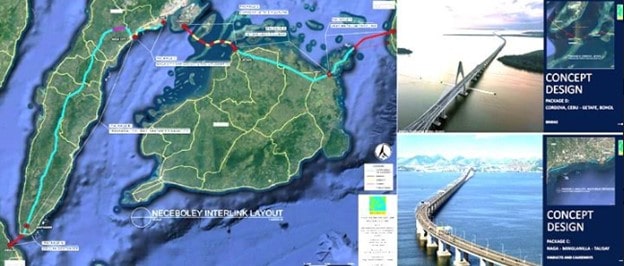
THE vision to make Bohol connected to Cebu thru a bridge though too far and as probably envisioned by then Gov. Erico B. Aumentado, may not be far-fetched, after all.
This came after the Business Mirror, a leading national broadsheet, reported the following article:
AG&P Industrial and the Visayas Neceboley Interlink Holdings Corp. (VNHIC) signed a memorandum of understanding (MOU) on Tuesday (last week) for a $15 billion mega infrastructure project that will connect the four major islands in the Visayas thru state-of-the-art bridges and expressways.
(Though it was not immediately known what Neceboley conveys. But it probably stands for Negros, Cebu, Bohol and Leyte).
AG&P industrial president Alex Gamboa said the colossal project will boost not only the economy of the provinces, but will also contribute to the country’s Gross Domestic Product, (GDP), the total goods and services produced in a given time.
“From a financial perspective, it’s going to be the biggest ever projects of AG&P in its history. I would say probably in its 125-year history. Right now, we estimate the direct cost of the projects we’ve ever done were a P460 million project and a $440 million projects,” Gamboa said.
“Imagine this one is 15 times those two combined projects. So, that’s one. The second is its impact on the Filipino people. This projects itself will directly impact 22 million Filipinos in the Visayas region. And imagine how it will impact at the national level right because there will be indirect impact to other industries, the business sector and all the of the other industries that did this,” he added.
The subsidiary of AG&P Group said Project Neceboley aims to connect the four islands in the Visayas —- Negros, Cebu, Bohol and Leyte.
Meanwhile, VNHIC was given certificates of acceptance thereby granting it original proponent status by the provincial government of Negros Oriental, Cebu, Bohol and Southern Luzon to develop Project Neceboley thru a collaborative joint venture initiative with provincial government under the Public-Private Partnership (PPP) framework.
Gamboa said AG&P will serve as technical lead for the project, as well as the execution arm of the group. He said the company will also provide financial backing to the project. At present, three major commercial banks are joining the project.
“In terms of commitment, it would require our entire workforce not to be part of this project. But the entire management of AG&P will be directly involved. And with the scale of this, we would have to raise the ante up and build up our organization to fully execute this project,” he said.
The project will be backed up by a private consortium of global partners that will finance, design, construct and maintain the bridges, road and mass transit network composed of four lane bridges with expanded expressways. Moreover, the consortium will also handle infrastructure works, such as the construction of ducts.
Other major sources of income of the project are from reclamation development, water supply and real estate development.
As the project proponent, VNHIC chairperson Angel Pio Veloso, jr. said the company will procure the requirements, plan and reporting based on the rules, regulations and policies of the local government units (LGUs) and engage AG&P Industrial in meetings with LGUs and other government institutions to ensure the alignment of obligations upon the award of the project.
The project will be executed in two phases. Phase I will be focused on the construction and operation of a 238.05-kilometer bridge, toll road expressway network that will link the four major islands of the Visayas.
It is further divided into six packages which will involve the building of a bridge spanning from Sibulan, Negros Oriental, to Santander, Cebu.
Phase 2 will be centered on land reclamation and horizontal development of 568 hectares foreshore and offshore in the Visayas region and the development of the reclaimed land into ready-to-use complexes for residential, commercial, industrial and other six tourism-related purposes. (Business Mirror)



